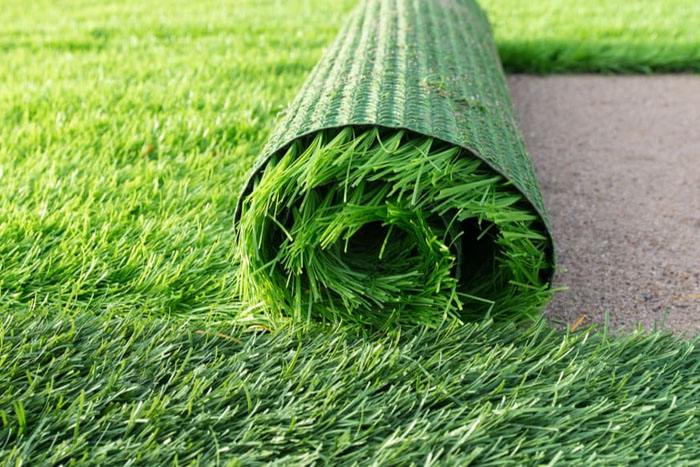Artificial grass is a wonderful alternative to having a real lawn. The transition can be easy, but we are sure you have plenty of questions.
How long does artificial grass last? A good, high-quality artificial grass lawn should last 10-20 years. Even though artificial grass needs less regular maintenance than a conventional lawn, you can expand its lifespan by keeping it clean. Hose down your artificial grass a few times a month and try to keep wear and tear to a minimum.
There are many steps you can take to improve the lifespan of your artificial grass. Keep reading to find out more about these steps and the hype surrounding artificial grass.
Table of Contents
The Lifespan of Artificial Grass

10-20 years is a generalized, broad span of how long your artificial grass could last. Typically, 10-15 years is a more likely lifespan, but if you take care of the artificial grass, you can easily make it function all the way through 20 or even 25 years.
When you consider going through with the installation of artificial grass, you should weigh the significance of several factors that could affect how long the grass lasts (see the bulleted list below). Some of these factors could increase the amount you spend on artificial grass and may even completely reverse your decision, but let’s hope not.
The lifespan of your artificial grass depends on these factors:
- Proper maintenance
- Presence of animals
- Climate
- Installation method
- Quality of the artificial grass
Artificial Grass Quality
The quality of the artificial grass you buy and install has a direct impact on how long the artificial grass stays attractive and useable. Manufacturers of cheaper, lower-quality brands of artificial grass use materials that are not necessarily weather-resistant and cannot withstand constant walking and playing.
For indoor use, the quality is not as important unless you want it to look extremely realistic. However, outdoor artificial grass is more exposed to the elements and needs to be durable in order to last a long time.
The composition of high-quality artificial grasses has a few materials, unlike its low-quality contenders, which have one universal material used for every part of the grass, including the artificial grass and its backing. Just looking at two artificial grasses of opposing qualities side-by-side, you can see the difference almost immediately. High-quality artificial grasses look like real grass, not plastic.
For your best chance at having the artificial grass last a long time, find a product that has polypropylene and polyethylene for the grass blades and a separate material for the backing.
How Long Does Artificial Grass Last in Harsh Climates?

Most artificial grasses are incredibly weather-resistant and can be a considerable improvement from a real lawn because the artificial grass will not die during harsh winters and summers. Piled up snow and heat from the sun can dry it to a crisp without causing any damage.
The main problem comes with cold climates because the snow melts and leaves behind puddled water. Artificial grasses have a backing that makes water absorb into the ground slower than it would when the snow melts on a conventional lawn. It is crucial that you find an artificial grass that drains well – it should have drainage holes on the back.
If you already have your artificial grass installed, and the climate has become a reoccurring problem for the maintenance of your artificial grass, you may have to resort to a more creative solution to prevent the grass exposure.
One thing you could try creating is a cover that extends from your house to protect your artificial grass from the weather. This will keep weather damage to a minimum throughout the year with little hassle on your part.
Artificial Grass Maintenance
Yes, the use of artificial grass substantially reduces maintenance labors compared to taking care of a patch of real grass, but it does not eliminate it.
For argument’s sake, you could install artificial grass and then leave it be, but between weather changes, urine and fecal matter left from pets, and intrusion from wild animals, damages will happen, and bacteria will thrive. An excess of bacteria could be harmful to pets and kids.
Follow these tips on general artificial grass maintenance, and you should be able to extend the life of your lawn.
Get the Leaf Blower Out
Use your rake or leaf blower to remove leaves, sticks, and other debris that could rot if left to decompose on the artificial grass. It takes minimal effort to quickly leaf blow your yard, and it will save you time that would otherwise be wasted trying to remove rotted debris.
Spray It Down
At least once every 1-2 weeks, use your garden hose to spray down the artificial grass. The water will remove residue from pet urine and feces, as well as dust, pollen, and other allergy-irritative particles.
Pick Up After Your Pet
Soon after your dog or pet does their business, pick up after them. Most urine soaks through the grass and gets washed away when you spray with the hose, but solid waste will become crusted to the artificial material and leave behind bacteria. Sometimes it may be easier to pick up poop after it dries so that it comes up in solid chunks, but do not wait too long.
Artificial Grass Is the Way to Go
You don’t have to trim your yard anymore! How exciting.
Although landscaping can be an enjoyable hobby for some people, most simply do not have enough time in the day to tend to a naturally growing lawn. Artificial grass cuts back on maintenance time significantly.
Do yourself a favor and hire an experienced professional to install your artificial grass. They can help ensure that the grass lasts a long time before becoming displeasing to the eye and dysfunctional.
Do not believe the myth that artificial grass lasts forever. So, just how long does artificial grass last? Artificial grass can stay nice for up to 25 years if you keep up with maintenance needs.




